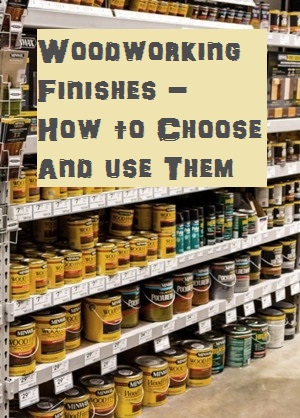
It doesn’t matter if you are new to woodworking or have been at it for decades, choosing the right woodworking finishes for your projects can be complicated.
What should I use as a finish?
Should I brush it, wipe it or spray it?
Tag along as we explore these options and several others, ending with some recommendations for getting started.
Types of Topcoats
Woodworking finishes can be broken down into two major types of finishes: Penetrating Oils and Surface Finishes. Penetrating oils are basically natural oils, often with synthetic resins added. By their nature, they soak in, or penetrate into the surface. Surface finishes, on the other hand, sit on the surface of the wood and create a protective barrier. Some of these can be thinned down, so they penetrate, and some oils can be built up, almost like a surface finish.
If your goal is the bare wood look, use a penetrating oil. If you want a glossy look or more complete protection, use a surface finish. So let’s dive into each of these categories and try to understand the differences they offer.
Penetrating Oils
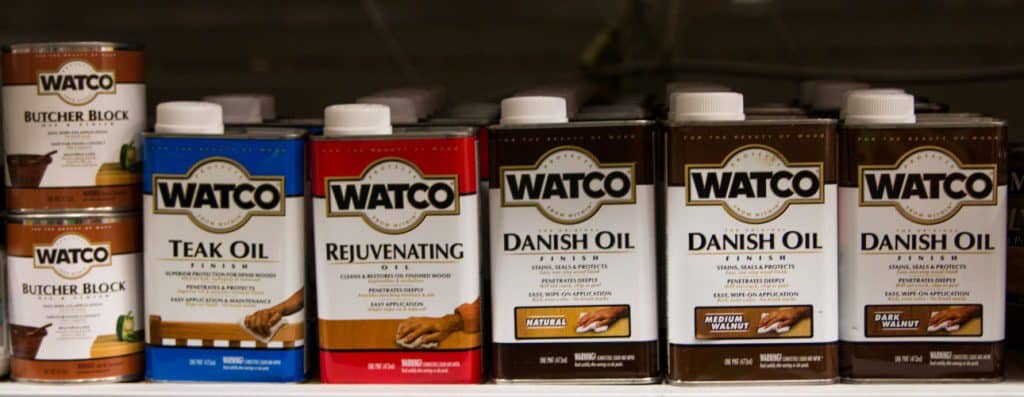
Penetrating oils are probably the oldest woodworking finishes ever used and many are still popular with a lot of woodworkers. Over the last 50 years, most of these products have been changed, modified and updated. They’re now blended with additives, like resins and driers, so they act more like a varnish. The following are the most popular choices on the market:
Boiled Linseed Oil (BLO)
Boiled Li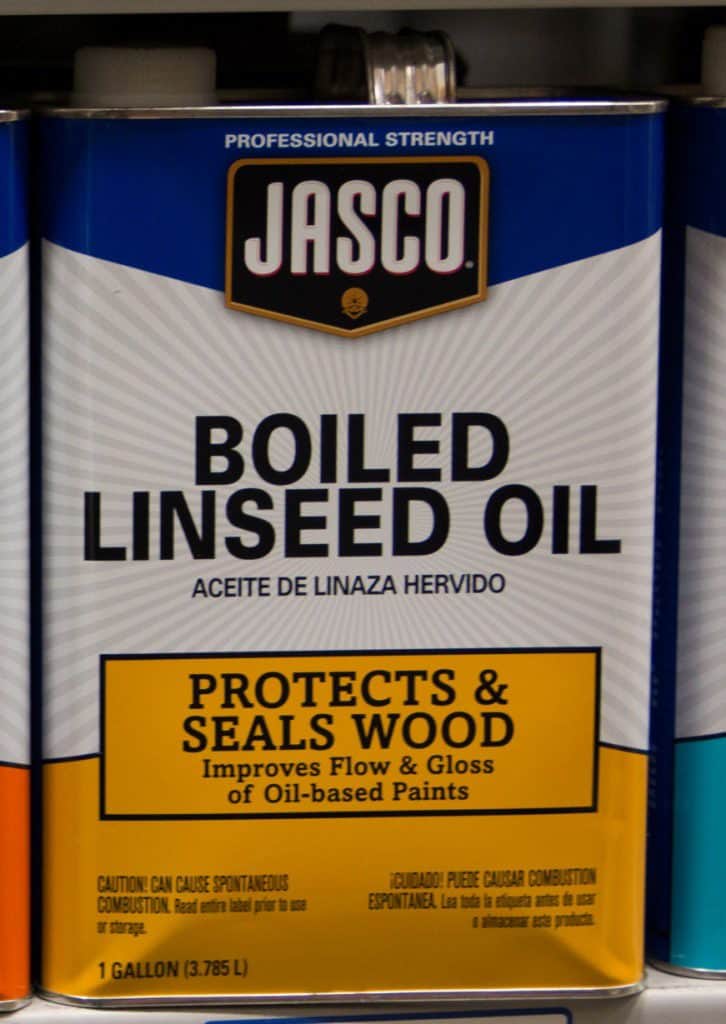 nseed Oil has been used since the 1700’s. It soaks into the wood and leaves a shiny, but not glossy surface. BLO has a warm, yellow, glow, that enhances the grain, but it does darken wood as it ages. It resists some wear and tear, however, it will absorb moisture if left standing. This finish dries slowly (full cure can take 30 days), and requires many coats. It has moderate resistance to heat, water and most chemicals. With care It’s safe to use, but the metallic driers are poisonous.
nseed Oil has been used since the 1700’s. It soaks into the wood and leaves a shiny, but not glossy surface. BLO has a warm, yellow, glow, that enhances the grain, but it does darken wood as it ages. It resists some wear and tear, however, it will absorb moisture if left standing. This finish dries slowly (full cure can take 30 days), and requires many coats. It has moderate resistance to heat, water and most chemicals. With care It’s safe to use, but the metallic driers are poisonous.
Warning: BLO soaked rages can spontaneously erupt. Lay them out flat on the concrete to dry out. See more details in the safety section below.
Danish Oil
Danish Oil is part of a family of woodworking finishes that includes: Danish oil, teak oil, and antique oil. Popular due to their ease of use, these resins preserve the feel of the wood and leave a fairly durable finish that can be easily patched or refreshed. They work best on hard, open-grained woods like walnut, oak or teak. However, on softwoods, or closed grained hardwoods, they can have mixed results. They can darken the wood, sometimes more than then you like, so test them on scrap woods first.
Tung Oil
Tung Oil is a natural oil, often blended with resins, and is built up with several thin coats. A fairly hard finish, it is resistant to abrasion, water, heat, acids and mildew. It’s shine increases with each coat, but will not become glossy. It has a warm glow, that is lighter than linseed oil. It can be difficult to apply if it is a 100% tung oil. Sanding is required between coats. Most tung oil offered today is actually an oil/varnish blend. Thick coats can wrinkle, so thinning before use is recommended.
Mineral Oil
 Mineral Oil is often overlooked when talking about woodworking finishes. That is unfortunate as it is a nontoxic option, a natural choice for wooden bowls, cutting boards and wooden utensils. You won’t get much more from it than a warm glow, and a renewing of the surface. It can be purchased at any pharmacy, and most grocery stores. Use a little at a time, or you will end up with a sticky film since it doesn’t really dry out. Warming the oil, before applying it, will help it to penetrate deeper. Plan on renewing the finish at least once a year, more often if it’s put in a dishwasher.
Mineral Oil is often overlooked when talking about woodworking finishes. That is unfortunate as it is a nontoxic option, a natural choice for wooden bowls, cutting boards and wooden utensils. You won’t get much more from it than a warm glow, and a renewing of the surface. It can be purchased at any pharmacy, and most grocery stores. Use a little at a time, or you will end up with a sticky film since it doesn’t really dry out. Warming the oil, before applying it, will help it to penetrate deeper. Plan on renewing the finish at least once a year, more often if it’s put in a dishwasher.
Penetrating oils are very difficult to remove later, since you have to remove all of the saturated wood, by sanding, planing or scraping.
And remember: rags soaked in any of these woodworking finishes may spontaneously combust (see safety section below for proper disposal).
Surface Finishes
Walk down the finishing aisle at your favorite home center, and you will see a LOT of choices in woodworking finishes.
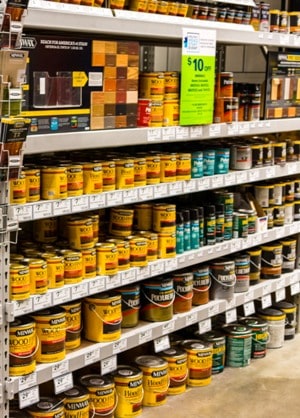
Most of these are going to be surface finishes, like polyurethane. The number of options seems to be growing every day, as manufacturers update, or repackage their offerings.
The trend toward water-based finishes is growing to meet the demand for environmentally friendly products.
Surface finishes are popular because we like a hard surface that is easy to clean. We like the shine and it “feels” like we are doing professional grade work. The following are the more popular surface finishes you will find:
Shellac
Shellac is truly one of the oldest woodworking finishes around. Its use in the western world dates to the 1500’s. And it’s still popular with many craftsmen for good reasons. Shellac is a simple, safe finish. It dry’s quickly, an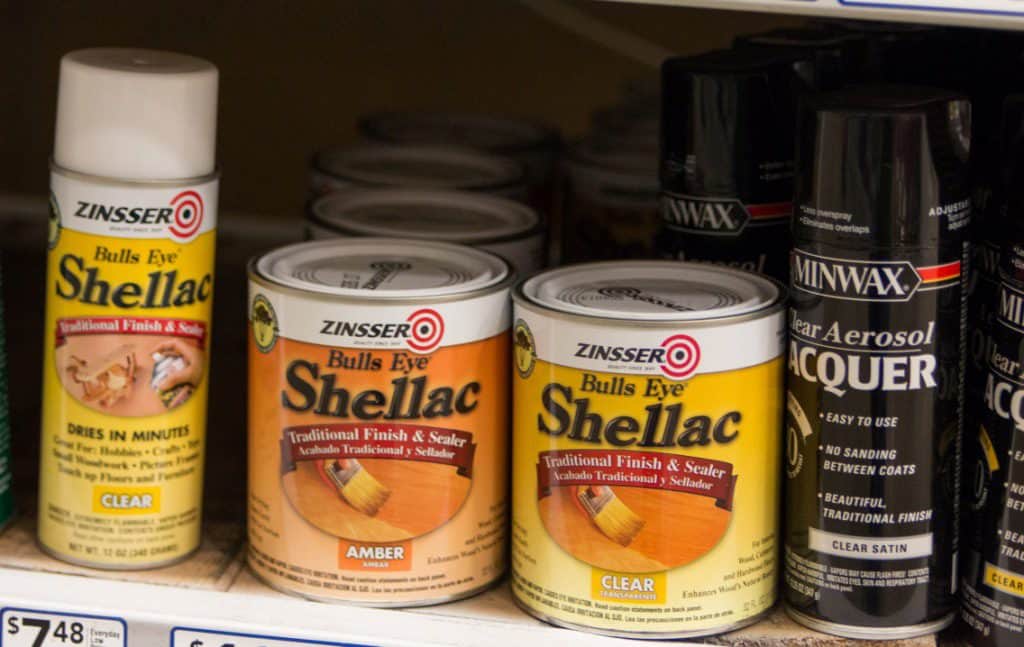 d multiple coats can be applied in a single day. Shellac has a warm, soft appearance, and has been used on fine furniture and musical instruments for centuries. Once dry, shellac is a safe product for the home, in fact, many drugs and foods are coated with shellac.
d multiple coats can be applied in a single day. Shellac has a warm, soft appearance, and has been used on fine furniture and musical instruments for centuries. Once dry, shellac is a safe product for the home, in fact, many drugs and foods are coated with shellac.
Color
If using pre-mixed shellac, you can choose either orange or white shellac. Orange is the most common product. It gives a traditional amber tone to woodwork. White shellac is been bleached to avoid, or reduce, the amber color cast. White shellac is not as resistant to moisture and has a shorter shelf life.
Shellac dissolves in alcohol, so it is not recommended for table tops, bars or dressers, where perfumes may be used.
What’s a “Pound Cut” anyway?
Shellac can be bought as dry flakes, or as a premixed liquid. Making your own is not difficult, and it you can control the concentration of the finish, properly known as “pound cut”. “Pound cut” refers to the pounds of shellac added to a gallon of alcohol.
As a starting guide, the following pound cuts are often used:
1-lb. – Pre-stain sealing, French Polish finishing
2-lb. – Pre-finish sealing; general wood finishing
3-lb. – Floor finishing; sealing knots & sap streaks
4-lb. – Sealing tough knots & sap streaks, stains*
* A 4-lb. cut is generally used by professionals
From “The Story of Shellac” by Zinsser Co., Inc.
Many woodworkers use a “spit coat,” or 1/2 -lb cut, to seal the wood before using other finishes, like polyurethane. It is recommended that a white, or bleached shellac be used, to avoid the natural waxes in the finish. Premixed shellac is usually sold as a 3-pound cut, which is a little heavy for general use. It needs to be thinned to a 2 pound cut for most uses.
Shellac Flake
Shellac flakes are mixed with alcohol, allowed to dissolve, then filtered before use, to get rid of natural debris, and un-dissolved flakes.
Flakes can be purchased in a number of colors, which are created by the lac bug, and it’s diet. They are dewaxed and bleached to lighten the tone. The more common colors, from lightest to darkest are Platina, Super Blonde, Blonde, Orange, Ruby, and Garnet.
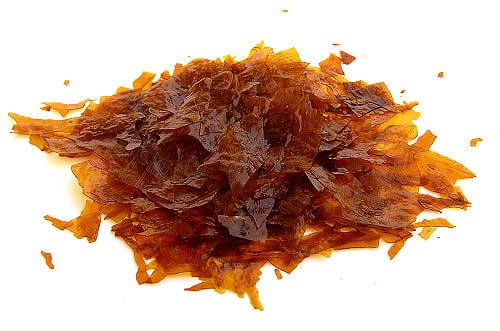
The best results will be from mixing with 190 proof, denatured alcohol. While most of the denatured alcohol offered today is not this pure, you can find it, so watch the labels. Avoid the 60 proof offerings, they can create problems. Because the finish will dissolve with alcohol, each new layer, melts the layer below, and they become a single, solid layer.
Shellac has a shelf life of about 6 months. Avoid buying premixed if older than this (packaging date is on the can). So whether it’s from the can, or you mixed it yourself you need to remember to check. To test if a batch of shellac is still good, put a couple of drops on a piece of glass, if it is dry to the touch in 5 minutes, it’s still good to use.
Applying Shellac
Shellac can be brushed, padded or sprayed successfully. When spraying, some experimentation will be needed to find the right cut. Too thin, and it will be nearly dry as it goes down, leaving a rough surface. More information on spraying below.
Lacquer
Lacquer is an older, but relatively new, technology for finishing. There are two sub-types for lacquer: Nitrocellulose and Pre-catalyzed lacquer.
Nitrocellulose Lacquer
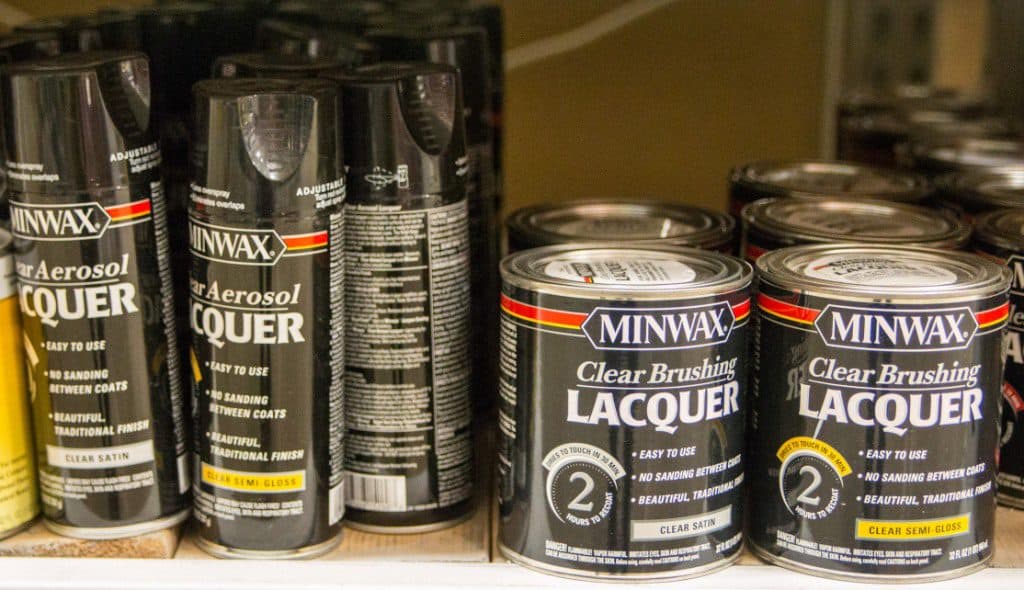 Nitrocellulose Lacquer is the older form, dating back to the 1920’s. It forms a transparent film, with good gloss. It offers good protection while being on the soft side. Lacquer can be brushed, padded or sprayed. Hot rodder’s loved this finish because it could create amazing looks. Few people know that in the 20’s they brushed the paint on new cars. The fumes can be toxic, so use good protection when spraying, especially. However, once dry the film is safe for general use.
Nitrocellulose Lacquer is the older form, dating back to the 1920’s. It forms a transparent film, with good gloss. It offers good protection while being on the soft side. Lacquer can be brushed, padded or sprayed. Hot rodder’s loved this finish because it could create amazing looks. Few people know that in the 20’s they brushed the paint on new cars. The fumes can be toxic, so use good protection when spraying, especially. However, once dry the film is safe for general use.
Lacquer is well known for its ability to be rubbed out to a high gloss. Like shellac, each additional layer of lacquer slightly dissolves the layer below. This is different from varnishes, where the layers remain distinct. With shellac and lacquer, the result is a single layer, so properly done, they won’t peal apart. It can be removed with lacquer thinner and is easily repaired with a fresh coat.
Pre-Catalyzed Lacquer
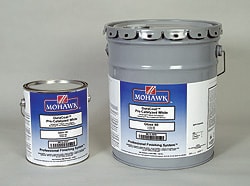 Pre-Catalyzed Lacquer has had resins added to add strength and durability to the finish. It has improved resistance to heat and moisture as well. The solvents and resins are toxic, but once fully cured the finish is safe for general use. It is more difficult to remove than standard lacquer. It can be brushed or sprayed. And of course, proper PPE is required.
Pre-Catalyzed Lacquer has had resins added to add strength and durability to the finish. It has improved resistance to heat and moisture as well. The solvents and resins are toxic, but once fully cured the finish is safe for general use. It is more difficult to remove than standard lacquer. It can be brushed or sprayed. And of course, proper PPE is required.
The finish can be rubbed out to a high gloss and can be purchased with additives to provide any other sheen desired. This is a professional grade finish, and is not available in smaller quantities (a gallon at a time). It has a 6-month shelf life once the catalyst is added, so make sure you can use it all since it pretty expensive too.
Polyurethane
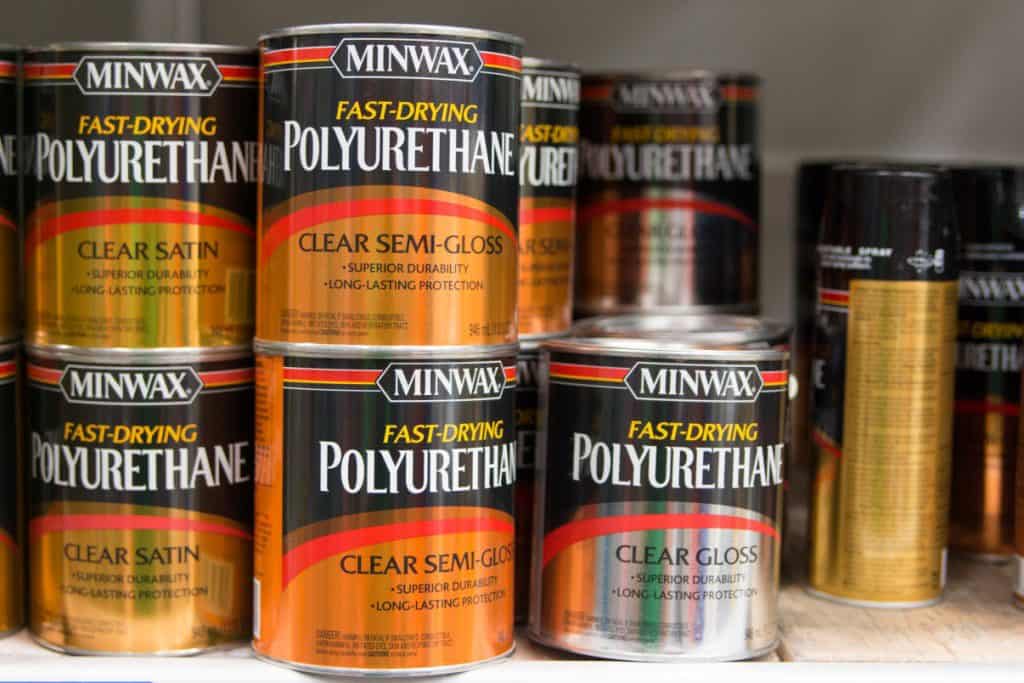 Polyurethane is the most common surface finish available at most home centers. It is a tough, durable finish. It can be rubbed out with steel wool or synthetic pads to reduce the sheen. This is what most commercial cabinets and furniture are finished with today. It is a very forgiving finish to apply.
Polyurethane is the most common surface finish available at most home centers. It is a tough, durable finish. It can be rubbed out with steel wool or synthetic pads to reduce the sheen. This is what most commercial cabinets and furniture are finished with today. It is a very forgiving finish to apply.
Oil Based Polyurethane
Oil based poly has a light amber tone, that is very durable, and safe after about a 7 day cure time. It is too soft to buff to a high gloss. It can be brushed, or sprayed on. Thin it down and oil based poly can be wiped on as well. Removal requires paint removers, so get it right the first time!
Water Based Polyurethane
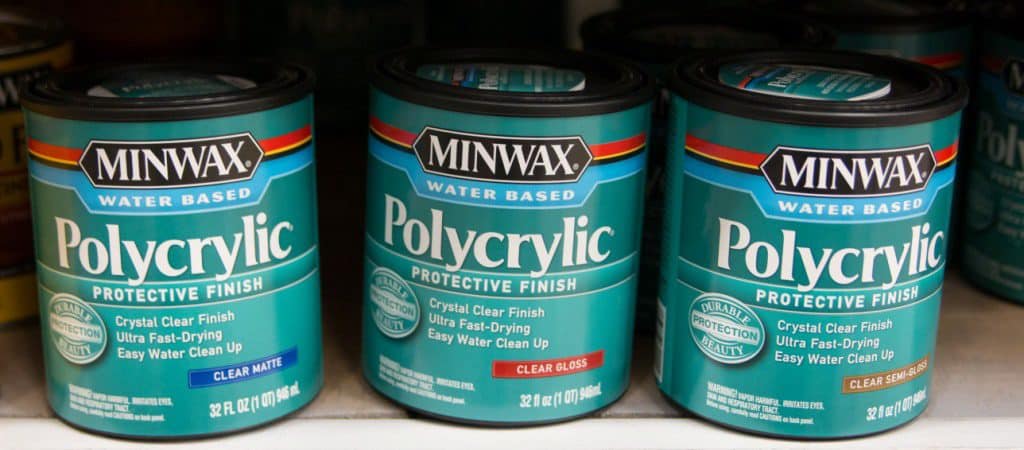 Acrylic Acrylic or water based polyurethane is transparent and now has good UV stability, slowing some wood color changes. It has a 10 day cure time, and is safer in its wet form, than the oil based poly. These acrylic finishes are very hard and can be buffed to a high gloss. It can be brushed, or sprayed on. Removal requires paint removers, as well.
Acrylic Acrylic or water based polyurethane is transparent and now has good UV stability, slowing some wood color changes. It has a 10 day cure time, and is safer in its wet form, than the oil based poly. These acrylic finishes are very hard and can be buffed to a high gloss. It can be brushed, or sprayed on. Removal requires paint removers, as well.
Note: There a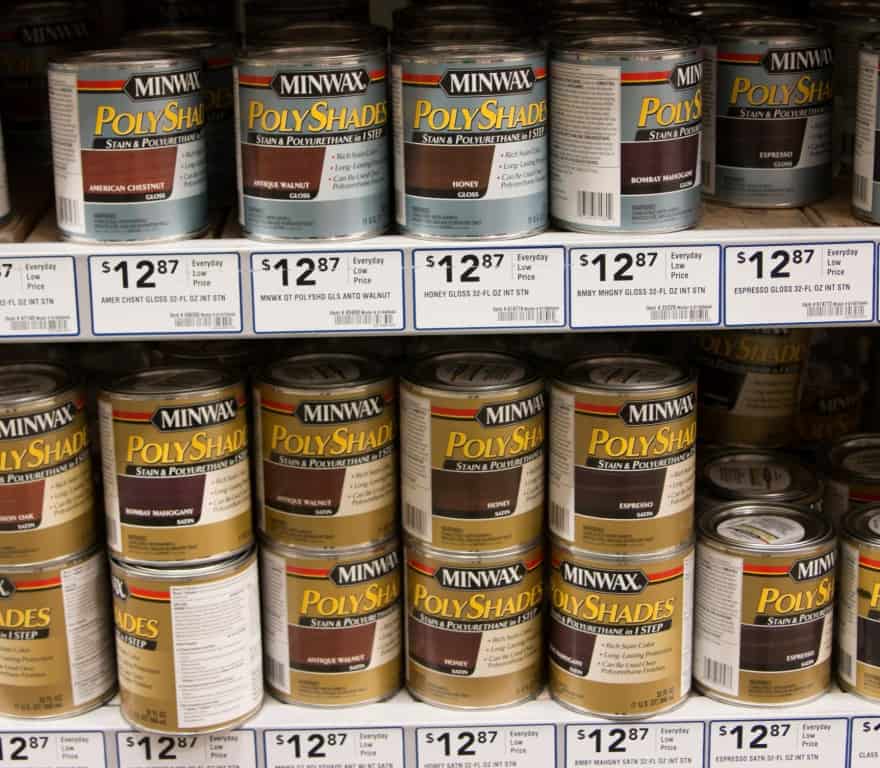 re polyurethanes that contain stains as well. This is a quick way to get a finish down, but the stain is sitting on top of the wood, and usually hiding the wood grain. I do not recommend this for any project that you have put your heart into, especially if you want to see that wild grain.
re polyurethanes that contain stains as well. This is a quick way to get a finish down, but the stain is sitting on top of the wood, and usually hiding the wood grain. I do not recommend this for any project that you have put your heart into, especially if you want to see that wild grain.
Spar Urethane
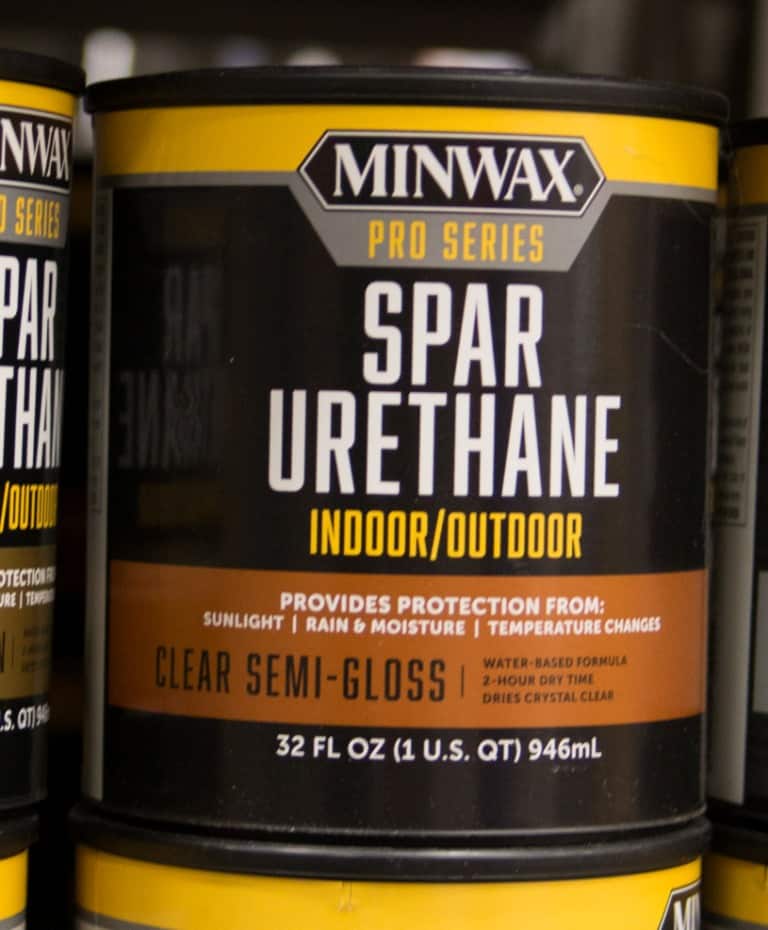 Spar Urethane, has been modified over the years, and most brands are now specialized polyurethane blends. It provides a soft flexible finish, that is able to move with temperature changes. Good for outdoor furniture, doors, windows and trim. A good choice for bathroom cabinets, bar tops, and kitchen countertops. However, they are not recommended for floors, decks or fences, because of their softness
Spar Urethane, has been modified over the years, and most brands are now specialized polyurethane blends. It provides a soft flexible finish, that is able to move with temperature changes. Good for outdoor furniture, doors, windows and trim. A good choice for bathroom cabinets, bar tops, and kitchen countertops. However, they are not recommended for floors, decks or fences, because of their softness
Wax
The last of The woodworking finishes that I want to discuss is wax, good old-fashioned wax. By itself, wax is not a very good protector of wood. Easy to put on and easy to care for. It’s also easy to repair. But as a protectant, it leaves a lot to be desired. There is very little abrasion protection, and it is very poor against heat or moisture. How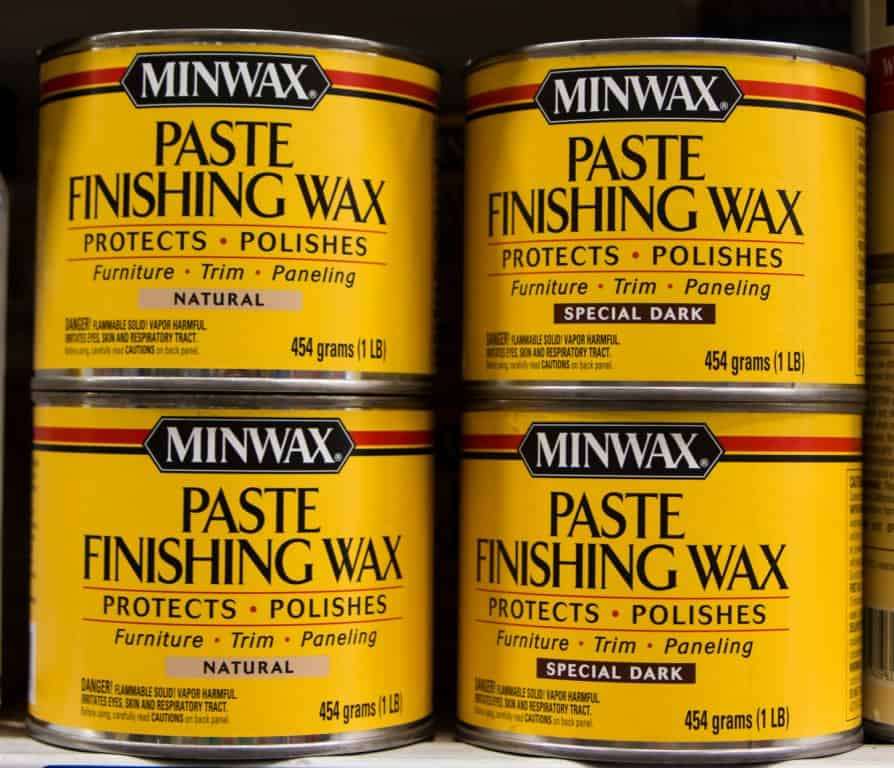 ever, add it to a good surface finish and you add another layer of protection to your project. For table tops and cabinets a nice wax finish, buffed out to a low-gloss, is the perfect way to cap off a project.
ever, add it to a good surface finish and you add another layer of protection to your project. For table tops and cabinets a nice wax finish, buffed out to a low-gloss, is the perfect way to cap off a project.
You can purchase wax as a paste, cream, or liquid. For furniture, I like paste wax. When I’m making pens I prefer a liquid wax just because of the way that I’m able to apply it. In both cases, all you need to do is wipe it off let it dry to a light Haze and then buff it out to get the look you want.
Top Coat Summary:
You need to know how the end product will be used. For small projects like jewelry boxes, I like tung oil for its feel and warm look. For children’s toys and quick projects I often use shellac. When finishing cabinets, or items that will see heavy use, I tend to use a polyurethane. And for outdoor furniture, a spar urethane.
Great, now how do get it on the wood?
Wood Prep
First, we need to make sure the surface is ready for the finish we’ve selected. So we start with sanding. Remove all surface blemishes with 100 or 120 grit aluminum oxide paper and a sander. Work your way through the various grits until you reach the desired final grit.
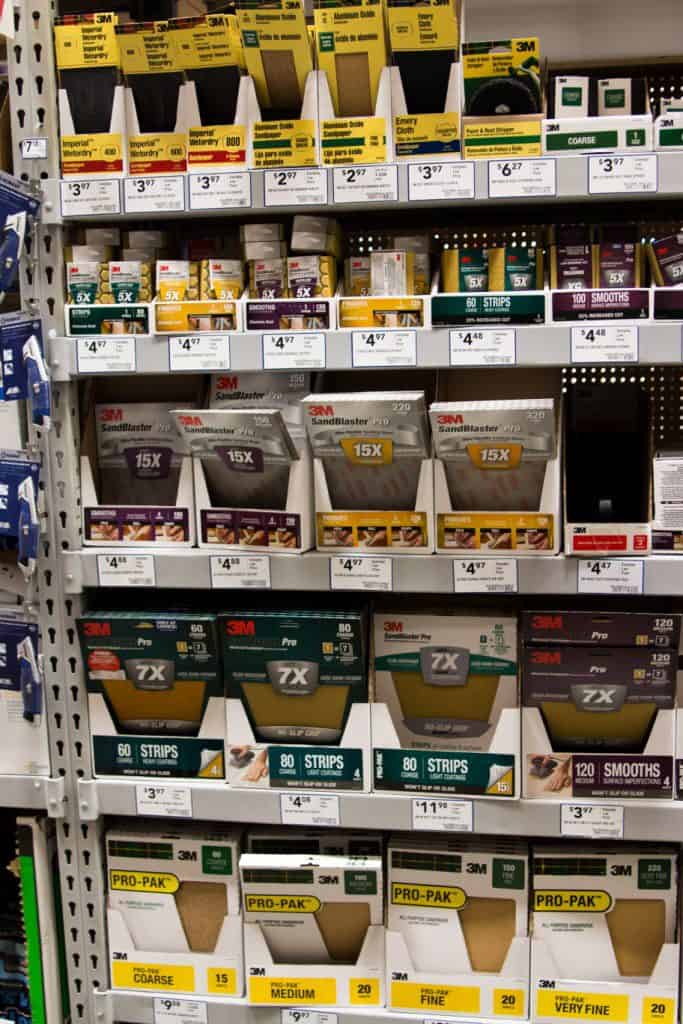
For an oil or penetrating finish, I stop at 150 grit. Sanding any finer than this keeps the oil, or stain, from penetrating the way you want it to. For varnishes and polys I sand to 220 grit, and with lacquer, I stop at 320 grit.
I like silicon carbide papers for anything finer than 240. The goal at each stage is to remove the sanding marks from the previous grit. After my final grit, I hand sand, with the same grit, in the direction of the grain, to remove any swirl marks.
Use a brush to remove the dust, and loose grit, between grits. Wipe everything down with a soft rag soaked in mineral spirits, and you are ready to apply that finish. While it’s still wet, look for any sanding scratches, or swirls you may have missed. If you see them now, you will see them in the finished product, so take another pass with hand sanding.
For more information on sand papers, see our article “Get A Grit On Sandpaper”
Safety
Before we get into the various methods of applying a finish, let’s talk safety. Read the labels on these products, they will tell you what PPE to use. If they tell you to wear a respirator or filter, do it. Wear rubber gloves and goggles.
The chemicals used are not your friends. This is especially true if you are spraying the finish since the chemistry is now airborne. Don’t freak out, if you follow the guidance you will be fine.
You will be using rags, either for applying or cleaning up the mess. A wadded up rag, soaked in these chemicals, can spontaneously combust. This is no way to lose a shop or house.
I mean it!
A pile of oily rags catching fire is a real risk, take steps to avoid it.
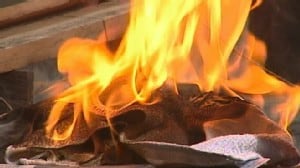
The recommendation from the industry is to hang them up or lay them out on the floor flat until they are dry. Dunn Lumber has a quick article on proper disposal.
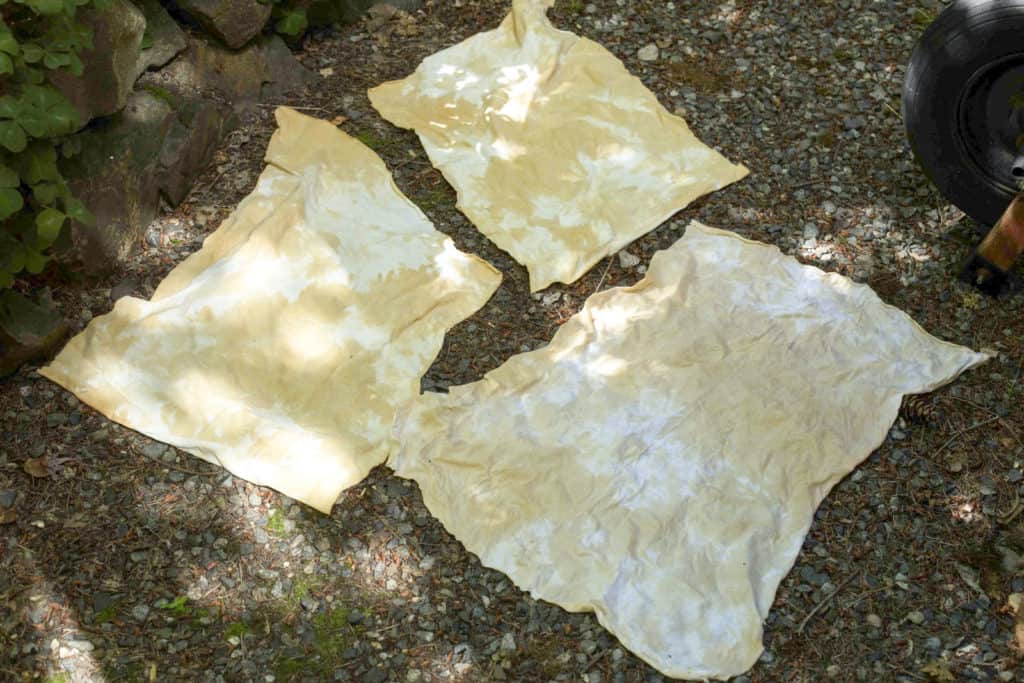
For most of the above finishes, the rag will become hard and brittle. You can also burn them, if you can legally do so, in your area. Some have also suggested putting them in a sealed container with soapy water, but this will have its own disposal issues.
Note: boiled linseed oil is the most likely to spontaneously combust. DO NOT leave these rags lying around. Do not put them in a sealed container by themselves.
Ways to Apply The Finish
Rags
The oldest and simplest method of applying a finish is with a rag. This works well for penetrating finishes, like tung oil, boiled linseed oil,… Wipe on a couple of coats, and let it dry until it’s no longer tacky to the touch.
With shellac and lacquer, you can “pad” the finish on. This technique takes practice to get good at it. Regardless, you can use thinned surface finishes as a wipe on sealer. If you want to learn more, search for French Padding.
Brushes
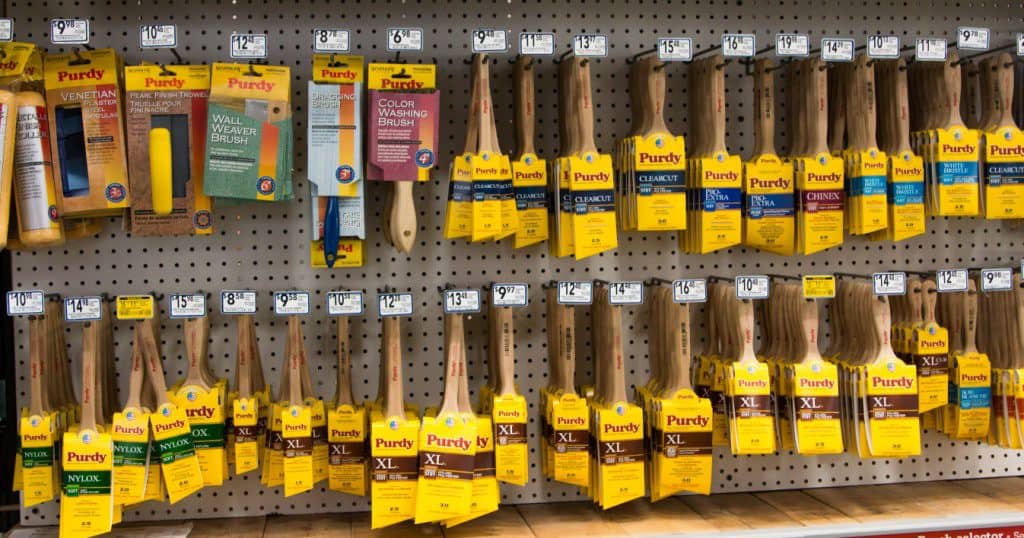
Whether you know it or not, there are a lot of options when it comes to paint brushes.
- Bristle materials fall into two types: natural and synthetic.
- Natural bristles are some type of animal hair, like badger, or hog. They are the best choice for oil-based finishes. They should not be used for water based finishes, since the bristles soak up the water, and swell, becoming limp. A limp brush makes it very difficult to apply the finish.
- Synthetic bristles are great for water based finishes. Most won’t give a great result with oils. However,there are now some synthetic brushes designed for both oil, and water based finishes. Read the brush package label, to see the manufacturers recommendations.
- Bristle Ends can be blunt, flagged or tapered.
- Blunt tips are used on cheap brushes, they are only good for stains. They can leave ridges and uneven surfaces in finishes.
- Flagged tips are used on better brushes and look like split ends on hair. They work well on oil finishes but can become clogged with water borne finishes. Tapered ends are the right choice for water borne finishes.
- Brush End Profiles also affect our ability to lay down a good quality finish.
- A flat profile (square flat end) is a bad choice for applying clear finishes, as they tend to leave ridges.
- Chisel-tip brushes have longer bristles in the middle of the brush, and shorter ones on the outside faces. They can be straight cut, or rounded in their shape. They do a better job of laying down a smooth finish.
- The end profile can be straight or cut at an angle.
- Angled ends allow for more control, especially in tight corners.
- Brush width is a simpler consideration. Choose a brush width that matches the project.
- Wide brushes work for wide panels.
- For narrower parts, use a brush that is slightly narrower than the part to avoid buildup along the edges.
- Foam Brushes: bottom line they don’t work for finishes. Some finishes can melt the foam. But regardless, a foam brush is a foam factory. I don’t like bubbles in my finish, so I don’t use them.
Brush Technique is pretty straight forward for a good looking finish on a panel:
- Start about 3 inches in from one end of the work piece. Brush toward the end, and off the board. This helps avoid drips and runs on the edges.
- Once the end is done, coat the rest of the board. Begin each stroke where you started in the first step. Work to the opposite end, overlapping your strokes.
- Once you’ve finished an area, tip off, or smooth the brush strokes out. Do not tip off on fast drying finishes like lacquer or shellac, for these finishes get it on, and leave it alone.
Spraying Finishes
Spray finishes are a quick way to get a lot of finish on a project. With practice, the finish will look fantastic.
No brush marks or bristles stuck in the finish. The cost of entry into spraying varies.
- Spray cans are “cheap”, but a big project will break the bank, buying them in bulk.
- Conventional spray guns are inexpensive if you own a compressor.
- HVLP systems vary widely in cost and features. Here’s the low down:
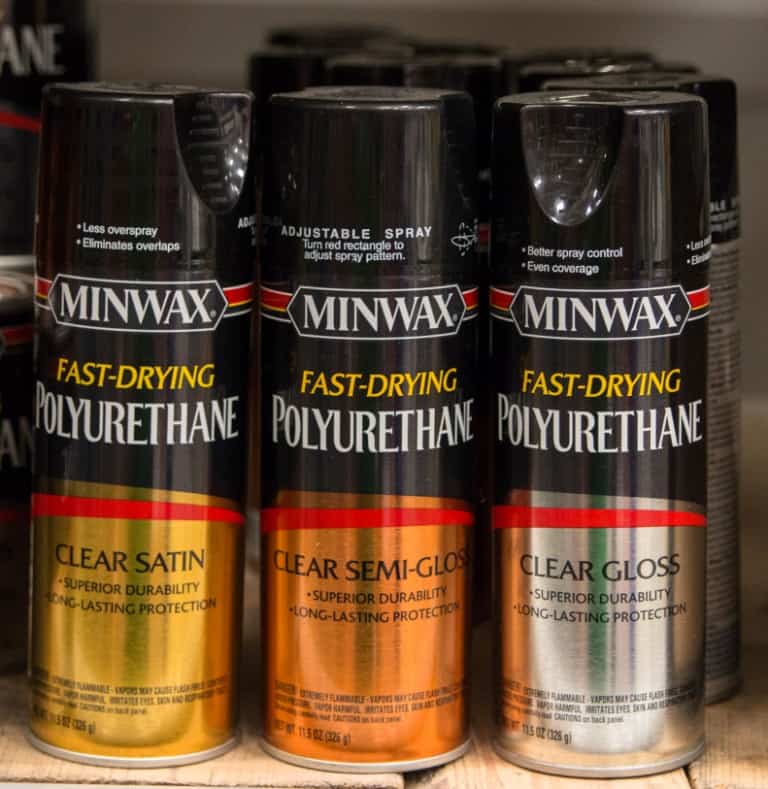 Spray Cans work well for small projects but are not recommended for larger ones. They put down thin coats, so it will take many coats by spray can, to build up a good surface. You can buy
Spray Cans work well for small projects but are not recommended for larger ones. They put down thin coats, so it will take many coats by spray can, to build up a good surface. You can buy
spray can versions of shellac, varnish, and polyurethane.
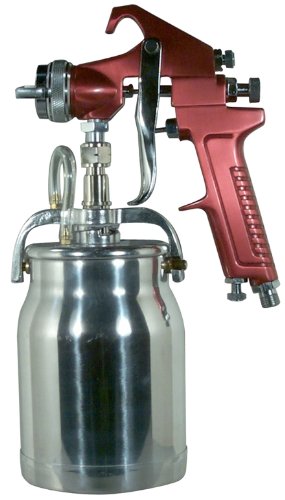 Conventional Spray Guns use higher pressure air (90 psi) to atomize and propel the finish. They can be suction guns, often called cup guns, where the finish is siphoned out of the canister from below, or gravity fed guns, where the canister is mounted above the gun. With a little practice, a great finish can be applied. One drawback is the amount of air consumed. Most hobbyist compressors cannot keep with the demand, and you can get uneven coatings, as the pressure runs down. These systems are not very efficient and will put 2/3 of the paint into the air, rather than on your project. They are inexpensive to get started with.
Conventional Spray Guns use higher pressure air (90 psi) to atomize and propel the finish. They can be suction guns, often called cup guns, where the finish is siphoned out of the canister from below, or gravity fed guns, where the canister is mounted above the gun. With a little practice, a great finish can be applied. One drawback is the amount of air consumed. Most hobbyist compressors cannot keep with the demand, and you can get uneven coatings, as the pressure runs down. These systems are not very efficient and will put 2/3 of the paint into the air, rather than on your project. They are inexpensive to get started with.
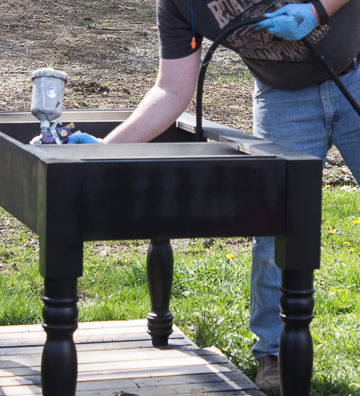 High Volume, Low Pressure (HVLP) Guns use lower air pressures (10 psi at the tip) to atomize and propel the finish. They apply a lot of finish with each coat (high volume means, high volume after all).
High Volume, Low Pressure (HVLP) Guns use lower air pressures (10 psi at the tip) to atomize and propel the finish. They apply a lot of finish with each coat (high volume means, high volume after all).
Even within this specialty product, there are a couple of choices.
- If you already own an air compressor, you can purchase a gravity fed gun, or a cup gun, designed for this use.
- Your other choice is a dedicated system. These consist of the gun, hose, and a turbine.
Turbines provide a large volume of warm air, at low pressure. Higher end turbines have multiple stages, which provide more power. More power means they can push more and heavier finishes.
Entry level turbine systems start at around $100, and high-end systems can run over $3,000. The single stage, low-cost systems do not give very good results with fine finishes, so choose wisely.
I have three options myself for spraying HVLP.
- My conversion gun works with a compressor.
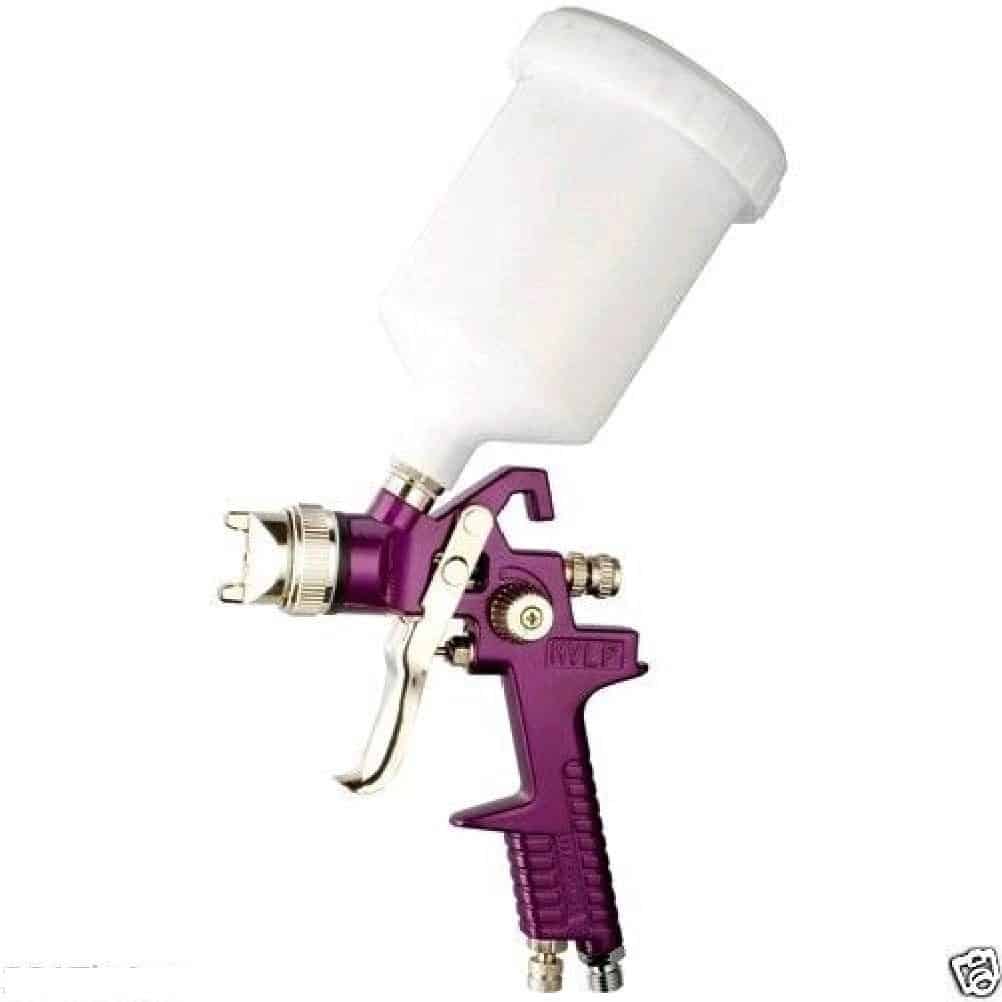
- I have an entry level, single stage turbine. It’s okay for paint, not so great for fine finishes.
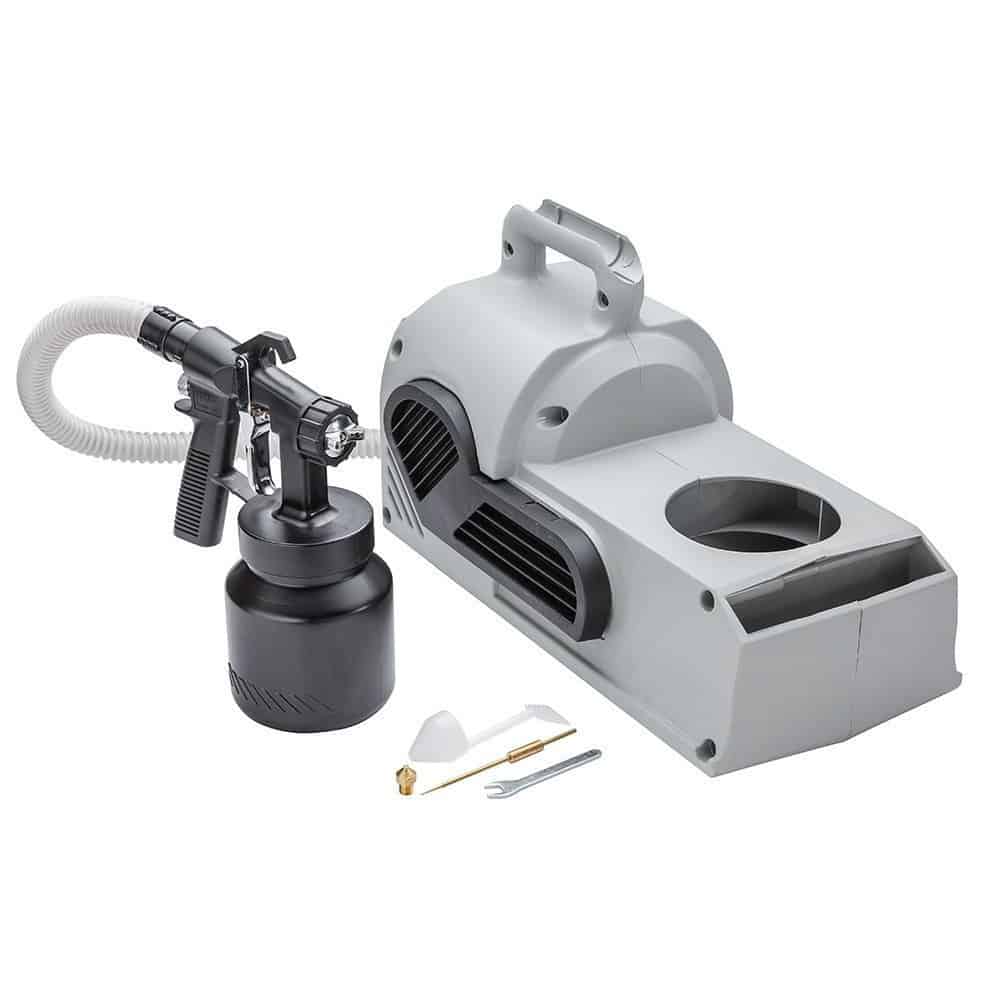
- My Apollo turbine is a pro system, that can put down a great finish. I was happy to find it used!
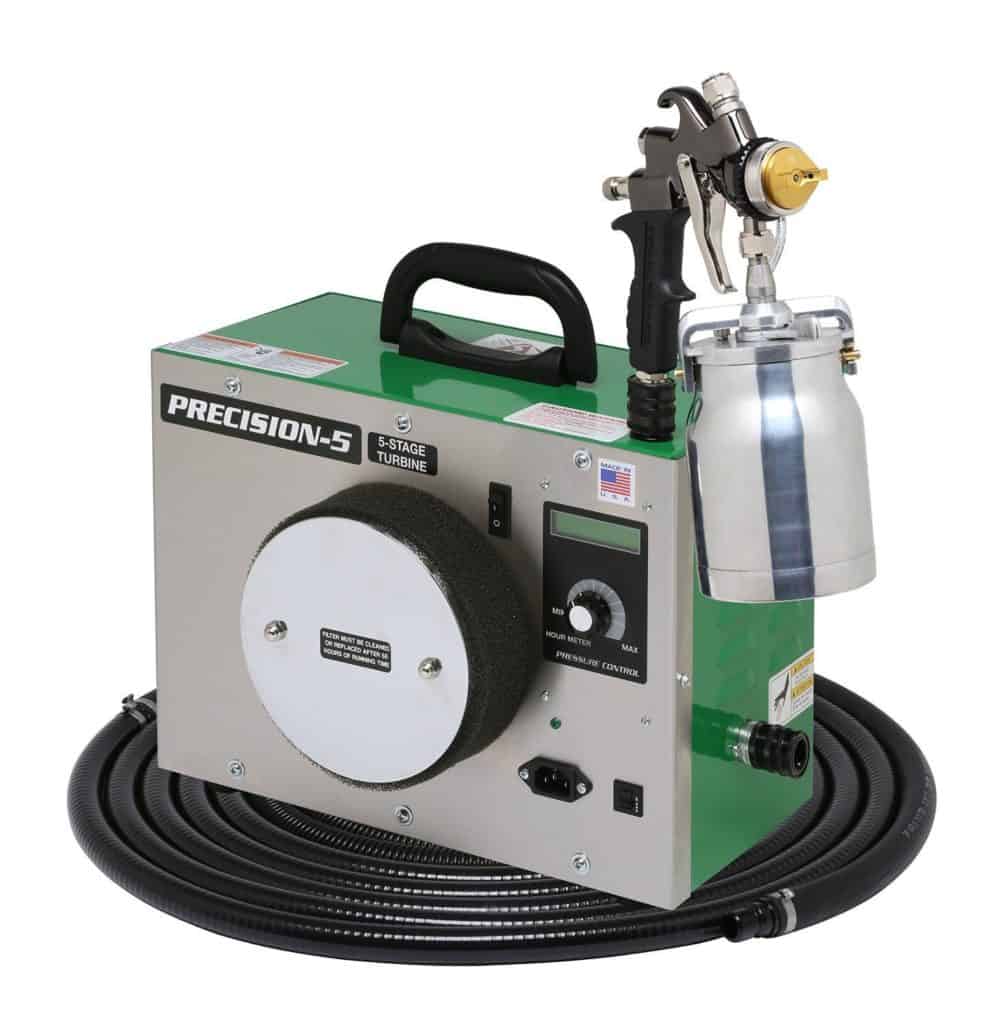
Recommendations:
Given the choice of spraying or brushing a complex, or large project, I always choose to spray with HVLP.
Brushing a rocking chair can take 20 to 30 minutes, per coat. Spraying it will take 5-10 minutes. HVLP is also a much easier to clean up after (over spray is kept to a minimum).
If you are just starting out, plan on getting a conversion HVLP gun. For $25 to $100 you can get a starter gun that will last you for years. Once you out grow it, you can choose what to upgrade to.
Conclusion
I hope you learned something from this. It is not hard to get started doing fine finishes, but it does take time, and practice to master. You should now know enough to make some choices and understand the options.
Drop me a note and let me know if there is anything I missed, or if you have any questions or comments. And please sign up for our newsletter!
Dan



Great information in comparison to most of the other topics I’ve discovered. Keep up the good work.
Does your website have a contact page? I’m having trouble locating it but, I’d like to shoot you an e-mail.
I’ve got some ideas for your blog you might be interested
in hearing. Either way, great website and I look forward to seeing it grow over time.
I love what you guys are usually up too. This kind of clever work and exposure! Keep up the great works guys I’ve you guys to my blogroll.
It’s interesting that pre-catalyzed lacquer has added durability, and resistance to water. I have been looking for something to use for floor finishes, but I wasn’t sure what to choose. I can see how it would be good to choose a finish that would be resistant to liquid, because my children spill things all the time.
It is in point of fact a nice and useful piece of info. I am happy that you just shared this helpful information with us. Please keep us informed like this. Thank you for sharing.
whoah this weblog is excellent i like reading your posts. Keep up the great paintings! You know, a lot of people are looking around for this information, you can aid them greatly.
Excellent. Absolutely loved reading and very helpful at the same time 🙂
Like!! Really appreciate you sharing this blog post.Really thank you! Keep writing.